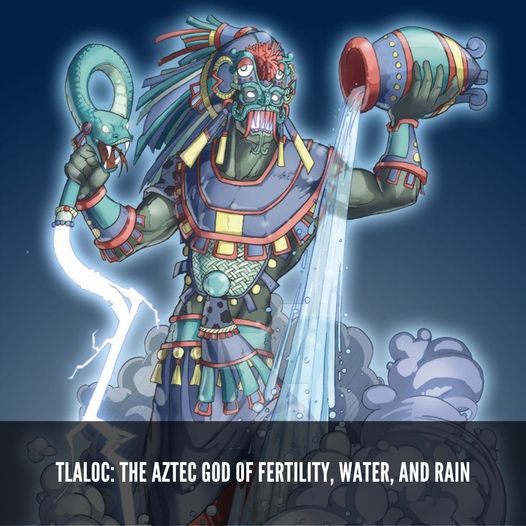Tlaloc, the Aztec god of rain, water, and fertility, stands as one of the most important and complex deities in the Aztec pantheon, embodying the life-giving and destructive forces of water. His worship, deeply rooted in Mesoamerican culture, predates the Aztecs, with origins traceable to earlier civilizations such as the Olmecs and Toltecs. This continuity highlights the enduring significance of water in these societies.
In Aztec mythology, Tlaloc’s dual nature is profoundly significant. He was revered for his ability to bring essential rain and feared for his wrath, manifesting in the form of floods, droughts, or thunderstorms. This reverence and fear reflect the Aztecs’ acute awareness of nature’s dual aspects—its capacity to both nurture and destroy.

Tlaloc is often depicted with distinctive goggle-like eyes and fanged teeth, symbolizing his connection to the rain and fertility. He is frequently associated with the color blue, indicative of his dominion over water. In artistic representations, Tlaloc is shown carrying symbols of his power, such as a lightning bolt or a water jar.
The worship of Tlaloc was central to Aztec religious life. He was honored in major temples like the Templo Mayor in Tenochtitlan, where he shared a dual shrine with Huitzilopochtli, the god of sun and war. This architectural pairing represented the balance between water and sun, essential for agriculture. Rituals to Tlaloc involved offerings, dances, and sometimes human sacrifices, particularly of children, as their tears were believed to appease the rain god and ensure a balance of rain for crops.
Tlalocan, the paradisiacal realm of Tlaloc, was envisioned as a place of abundance and eternal spring, where those who died from water-related causes found refuge. This belief in an afterlife free from earthly suffering under Tlaloc’s benevolent rule offered hope and consolation to the Aztecs, highlighting the cultural importance of water and the afterlife.
In modern times, the legacy of Tlaloc persists in Mexican culture, symbolizing the enduring power of water and its significance in environmental and agricultural discussions. He continues to inspire art and literature, serving as a reminder of the rich heritage of pre-Columbian civilizations and the timeless interplay between humans and the natural world. Tlaloc’s enduring presence in cultural consciousness reflects a deep-seated recognition of nature’s nurturing and destructive capacities, a concept as relevant today as it was in ancient times.
